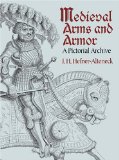Explanation of the Parts of a Knights Armor
|
|
There are of course a whole lot of variations in armor and it changed a lot over the centuries. But when we think of armor we think of a full suit of plate armor as shown in the picture below. Something like this was the typical armor around the 13th to 15th centuries.
We call them "suits of armor" but they didn't use that term. Generally they referred to them as an "armor" a "harness" or even as a cap a pied which in French literally means from cap to foot.
Along with the picture I have a listing of the names of the various parts. |
An Explanation of the parts of the armor

- A - Helmet - head armor. This came in a lot of different types including ones with hinged front face pieces.
- B - Gorget - this protects the neck area and is often segmented of different plates
- C - Spaulder - The shoulder protection. Sometimes they are also referred to as epaules
- D - Arm Harness - The several parts that make up the arm protection. The lower part of this armor from the elbow to wrist is called the Vambrace.
- E - Gauntlet - protects the hands
- F - Chest piece also known as the Cuirass. Typically it was in two halves. One half in the front and one half in the back. The back piece would be called the Back Plate.
- G - Leg Harness - This is the complete assembly for the leg protection. The upper part of the leg armor is called "Cuisses"
- H - Greave - Protects the lower leg. Sometimes there was just a front section to the greave with no protection the back of the leg. This type of half greave would be called a demi-greave.
- I - Poleyn - a flaring piece of armor that protruded out and protected the side of the knee.
- J - (not shown) Solleret which was a segmented foot covering

I have lots of interesting articles about knights, their weapons and their organizations right here: Articles about Knights
 Medieval Arms and Armor: A Pictorial Archive (Dover Pictorial Archive) Medieval Arms and Armor: A Pictorial Archive (Dover Pictorial Archive)
This handsome archive depicts richly detailed armor and weaponry dating from the early ninth century to the mid-1700s. Adapted from decorative ornamentation on burial monuments and manuscripts, hundreds of finely executed images depict authentic shields, swords, crossbows, helmets, and ornate suits of body armor for knights and their steeds. 100 black-and-white plates.
|





